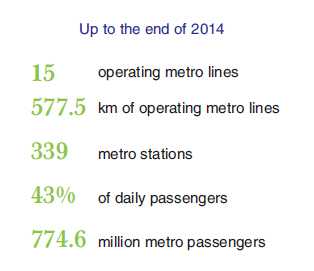Current Status and Future Planning of the City's Transportation
Transportation network has been significantly extended
Aviation: Take Pudong and Hongqiao airports as the foundation. 89.65 million passengers and 3.61 million tons of cargos were shipped via two airports in 2014.
Seaport: Take Yangshan Deep-water Port and Waigaoqiao Port as the primary port. 755 million tons of cargos and 35.39 million TEUs were shipped in 2014, ranking world No.1 for four years. Take International Tourist Center and Wusong International Cruiser Dock as the primary dock and Waigaoqiao Cruiser Dock as the complementary dock. 1.2-million tourists for cruising were served in 2014.
Railway: Form the network of three main railway stations (Shanghai Station, Shanghai South Station and Shanghai Hongqiao Station) and three auxiliary railway stations (Shanghai West Station, Anting North Station and Songjiang Station). The city has 456.3 km of railway up to 2014. The passenger throughput totaled 84.3 million or 252,000 per day and cargo throughput totaled 5.49 million tons in 2014.
Road: Form the network based on “two rings, nine spokes, one vertical, on horizontal and tow connecting”. The city has 12.945 km of roads with a total space of 173.68 million sq meters in 2014.
River: River network has been planned as “one ring plus ten connects”. Level-3 river lanes totaled 106.96 km and river lanes of level 5 or above totaled 1,965.9 km.
Public transportation has become more attractive
 The city has 1,338 bus lines. In the 70 percent of the central city, you can find bus stations within 300 meters. Bus lines have been extended to 95 percent of suburban villages. 161.8 km bus lanes have been established, which helped increase the average speed to 15.3 km/h. 6.584 billion passengers were traveled or 18.04 million per day. 42.9 percent of passengers chose the metro, 40.4 percent chose buses and 15.7 percent took the taxi.
The city has 1,338 bus lines. In the 70 percent of the central city, you can find bus stations within 300 meters. Bus lines have been extended to 95 percent of suburban villages. 161.8 km bus lanes have been established, which helped increase the average speed to 15.3 km/h. 6.584 billion passengers were traveled or 18.04 million per day. 42.9 percent of passengers chose the metro, 40.4 percent chose buses and 15.7 percent took the taxi.

 Print
Print Mail
Mail




